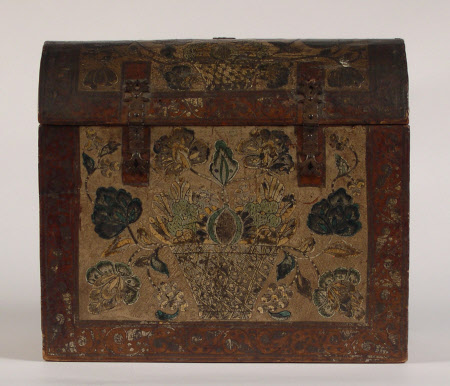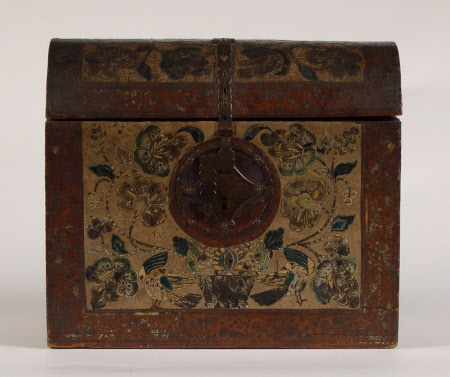Casket
Category
Furniture
Date
circa 1700
Materials
Mopa mopa, silver leaf, cedar, bamboo, iron, brass
Measurements
22.6 x 26.2 x 13.9 cm
Place of origin
South America
Order this imageCollection
Bateman's, East Sussex
NT 761758
Summary
A barniz brilliante dome-topped casket, South American, probably made in Quito (now part of Ecuador), circa 1700. Of boarded construction, probably made from Spanish cedar, and with bamboo pegs. The domed top hollowed out from a single board. Fitted with iron round lockplate, shaped hasp and hinges, all later and fixed with later brass pins. The vacant interior with evidence of some later intervention. Decorated all over with layers of the plant resin mopa mopa, some pigmented, possibly with lead white, indigo and carbon black, some laid over silver leaf. Decorated to all sides with a symmetrical design of flowers emanating from a central woven basket with fruits - that to the front flanked by birds, each with one wing raised - and all within a wide border of trailing foliage against a reddish ground.
Full description
This casket, formerly considered to be Spanish, was first recognised as being South American, and decorated with a type of resin obtained from the mopa mopa tree, in March 2022. Specifically, and because one of the layers in its decoration has been identified as silver leaf, it is described as barniz brilliante, a sub-type with a distinctive metallic sheen. Pasto, in Colombia, was an important centre for the production of barniz, but it was also produced in other parts of South America since ancient times. Mopa mopa resin is difficult to harvest and requires lengthy processing to turn it into thin sheets of clear varnish or lacquer, which can then be coloured (with pigments like indigo, lead white and carbon black) or be laid over silver leaf. The South American craftsmen and artists who carried out this task, called barnizadores, make the material pliable by chewing it. Although it is an art still practised in South America, in 2020 it was included in the List of Intangible Cultural Heritage in Need of Urgent Safeguarding by UNESCO. Subsequent to the discovery of the true origins of this casket, and in collaboration with conservators at the Victoria & Albert Museum, it has undergone non-destructive and non-invasive scientific and material analysis using infrared reflectography (to identify and examine any under-drawing and any possible later interventions), scanning XRF (both to identify chemical elements and to reveal the underlying structure) and digital microscopy (to obtain a high-resolution record of the casket's surface and its condition and to reveal stratigraphy where possible). This analysis produced some wonderful findings, not least the presence of the thumb marks formed by craftsmen who made this casket in South America over three-hundred years ago. Analysis also revealed that the box was probably made of Spanish cedar, fixed together with small pegs made of bamboo. The decorated areas to this box are made up of six distinct layers upon a cedar substrate - 1. a transparent, reddish layer; 2. a white background containing lead; 3. dark blue underdrawing; 4. undyed mopa mopa; 5. silver leaf and 6. dyed or undyed mopa mopa. The border is made up of layers 1., 5. and 6. Much of the silver leaf has tarnished over time. The decoration includes South American flora and fauna, and the style may have been influenced by East Asian lacquer which had reached South America in the 16th century. The true meaning or symbolism of this particular composition is not entirely clear, but it may symbolise abundance or fertility. An ancient art, the production of Barniz de Pasto continued under Spanish colonial rule in South America from the early 16th century. As a result, some surviving barniz de Pasto objects bear Catholic iconography. Other objects, such as book or missal stands, were made for use as part of Catholic liturgy. Some of these objects bear inscriptions and others are dated, important clues for understanding where, when and by and for whom these objects were made. This casket at Bateman's bears a resemblance to other objects made in Quito, now in Ecuador, which borders Colombia to its north. In 1563, Quito became the administrative centre of the Viceroyalty of Peru, a Spanish imperial province. Quito, as part of the Department of Guayaquil, was the first Ecuadoran territory to secure independence in Spain in 1820. We do not know when or how this casket came to be at Bateman's. The four paper labels still stuck to the casket, some bearing digits written in ink, together with the replacement metal fittings, imply that it may have been in another collection or collections, or passed through the trade, before it was acquired by the Kiplings. Reputedly, Elsie Bambridge née Kipling (1896-1976) purchased the box whilst on her honeymoon in Spain in 1924, giving it to her parents Rudyard (1865-1936) and Caroline Kipling (1862-1939) on her return. The derivation of this account is unclear, but it is worth remembering that Elsie Bambridge was still alive – living then at Wimpole – when Caroline Kipling died in 1939 and left Bateman’s to the National Trust, so she herself could have passed the story on. In addition, Elsie and her husband, George, spent a considerable amount of time in Spain, since he was a British diplomat posted to Madrid from 1925-8. It may also be worth noting that Rudyard and Carrie themselves travelled to South America – visiting Brazil – in February and March of 1927. Kipling regularly purchased objects on his travels – Bateman’s is full of them – and took a keen interest in how Bateman’s was furnished, even designing the day-bed (NT 760855) which is still in his study there. He wrote to his daughter Elsie from Brazil, saying that Carrie had ‘been out...looking at old furniture and silver’. However, no further detail is given in the letter, and a series of seven travel letters, written for publication and first printed in London in The Morning Post in 1927, do not mention the casket either. The earliest documentation for the casket dates from 1939, part of the administration of Caroline Kipling's estate on her death that year, when the casket was included in a list of 'Articles [at Bateman's] declared to be of national, &c. interest' in The Parlour as 'A [sic] old Spanish wood casket with hinged dome top'. It was also listed in The Parlour, and with the same description, in a 'Schedule', drawn up in 1940, of goods at Bateman's bequeathed to Elsie Bambridge. This document, albeit dated March 1940, may actually also refer to bequests made by Rudyard on his death in 1936. Elsie did not remove the casket from Bateman's to her home at Wimpole, presumably, although not certainly, because it had been designated as being of national importance.
Provenance
Included in a 1939 list of 'Articles [at Bateman's] declared to be of national, &c. interest', where it was described amongst the contents of The Parlour as 'A [sic] old Spanish wood casket with hinged dome top'. Listed in a 'Schedule' drawn up in March 1940 (which may refer to bequests made by Rudyard Kipling in 1936) of goods at Bateman's bequeathed by Caroline Kipling (1862-1939) as 'An old Spanish wood casket' in The Parlour. Bequeathed with the contents of Bateman’s to the National Trust in 1939 by Caroline Kipling.
Marks and inscriptions
Underside and interior: There are four paper labels to this casket: 1 circular with serrated edge and bearing inscription (in black ink) '85[?]' 2 rectangular with serrated edge and inset blue printed line with inscription (in black ink) '2/162' 3 Partial torn paper label 4 Label with straight top edge and rounded bottom corners with inscription (in blue ink) '1/4?'
References
Geminiani, L., Carvajal, M., Schmuecker, E., Wheeler, M., Burgio, L., Melchar, D., Risdonne, V., 'A Recently Identified Barniz Brilliante Casket at Bateman's, the Home of Rudyard Kipling', Heritage 2024, 7, 1569-1588



